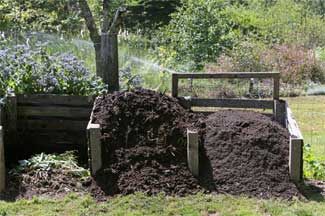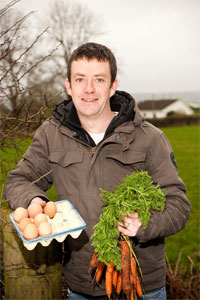Grow it Yourself - February
 The other evening I was going through some notes from a course on soil fertility I attended a few years back with Jim Cronin on his smallholding in Bridgetown, Co Clare. Jim is a rare breed – a wise sage who wears his considerable wisdom lightly.
The other evening I was going through some notes from a course on soil fertility I attended a few years back with Jim Cronin on his smallholding in Bridgetown, Co Clare. Jim is a rare breed – a wise sage who wears his considerable wisdom lightly.
The two greatest materials for returning fertility to soil, he says, are seaweed and homemade compost. Both rank a "10" on his scale of fertility. Farmyard manure composted for one year ranks an "8" while fresh manure (oddly) only ranks a "7". On the other hand a very old farmyard manure heap with nettles growing on it only ranks about a "1", because all the nutrients have leached away.
So how do you make compost properly? ?Treat your heap not as place where you can happily dump all manner of stuff from the kitchen and garden, but with love and respect! It’s like making a loaf of bread - make sure you have the right mix of ingredients.
With compost you have to have a 50/50 mix of green and brown material and you have to build up the layers carefully.?The brown layer can consist of straw, hay, wood ash, cardboard, twigs, leaf mould, soil or garden "sweepings". ??The green layer should contain seaweed, farmyard manure (hens, pigs, ducks, cows etc), grass, hedge clippings and kitchen waste (veg only).
 Jim is a fan of completely open heaps - that is, you basically pick a corner of your garden and start a heap on bare soil which you dig roughly before you start (which encourages earth worms to come up through the heap). There are no "walls" but the basic measurements of it should be about 4ft wide and deep. Start with a brown layer such as straw or twigs of at least 10 inches.
Jim is a fan of completely open heaps - that is, you basically pick a corner of your garden and start a heap on bare soil which you dig roughly before you start (which encourages earth worms to come up through the heap). There are no "walls" but the basic measurements of it should be about 4ft wide and deep. Start with a brown layer such as straw or twigs of at least 10 inches.
Turn the heap with a fork monthly to aerate it - cover it with cardboard or old carpet to keep the worst of the weather off it. Carry on adding alternate layers of 10 inches or so of brown and green. When you get to about 6ft high its time to move on to a new heap and let that one to rot down.
How long this takes depends on what’s in it - could be 4-6 months but you will know when its ready by the fact that you have a nice crumbly compost with few or no traces of straw in it - in other words that everything has rotted down. ?The overall goal is that you be self-sufficient in the material that you need to fertilise your soil - or as Jim puts it - you "close the gate on fertility". He estimates that you will get approx 20-30 wheelbarrows of compost from each heap you make.
That sounds a lot, but each spring you will need a wheelbarrow of compost for each square yard of veggie bed.
Things to Do This Month
To Do
Turn over the soil only if the weather is dry – if the soil sticks to your boots it’s too early for digging! Keep off the soil to prevent soil compaction - use timber planks to stand on for access.
If you have not already done so order/buy your seeds, spuds and onion sets. “Chit” or sprout seed potatoes – put them in a container (e.g. used egg carton or empty seed tray) and leave them in a bright warm place.
Check the pH of your soil – you can buy a soil pH testing kit in any garden centre. Lime your soil now if required (to reduce acidity in very acid soils), particularly important in your brassica bed.
Sow
Finally, we can sow some seeds. On a sunny windowsill indoors, in a heated greenhouse or on a heating mat: sow celery, globe artichokes, celeriac, leeks, onions, lettuce, tomatoes, peas, aubergines, peppers/chilli-peppers.
In polytunnel or greenhouse: beetroot, Brussels sprouts, summer and autumn cabbage, carrots, leeks, lettuce, radish.
Outside: Weather permitting you can try planting out broadbeans, spinach, kohlrabi, onion and shallot sets, Jerusalem artichokes, parsnip and early pea varieties.
Harvest
Winter cabbage and cauliflowers, Brussels sprouts, spinach, kale and leeks.
Recipe of the Month – Spinach and Cheddar Souffle
This recipe is from Donna Hay’s Modern Classics cookbook. The word souffle needn’t fill you with terror – it’s quite straightforward, if a little fiddly. If you are growing spinach and have your own hens, then this is really a ‘store-cupboard’ recipe that won’t require a trip to the supermarket.
Ingredients:
• 1 bunch spinach leaves (about 400g)
• 60g butter
• 4 tablespoons plain flour
• 3 cups milk
• 4 eggs, separated
• ½ cup grated cheddar
• a handful of breadcrumbs
Place the spinach in boiling water and remove after one minute and drain. Squeeze all the excess liquid from the spinach and then chop.
Melt the butter in a saucepan over a medium heat. Add the flour and stir until smooth. Whisk in the milk and stir briskly until the sauce thickens. Remove from the heat and stir through the spinach, egg yolks, cheese. Season well with salt and pepper. Allow to cool to room temperature.
Preheat the oven to 210 degrees celsius. Grease 4 x 1-cup capacity ramekins with butter and sprinkle with dry breadcrumbs to coat. Beat the egg whites in an electric mixer until soft peaks form. Gently fold one-third of the egg whites through the spinach mixture and then the remaining two-thirds. Spoon in to the ramekins and place them on a baking tray.
Bake for 15 minutes until puffed and golden. Do not open the oven door while cooking.
Tip of the Month – Rejuvenate perpetual spinach
Perpetual spinach plants may be looking a little tired at this time of the year but with the milder weather should also be showing signs of new growth, particularly at the centre of the plant. Cut the larger outer leaves with a sharp knife at the bottom of the stem so that the plant can concentrate on this new growth.
------------------------------------
We are trying to get 100,000 people to take a pledge to grow something they can eat – take the GIY pledge at www.facebook.com/giyireland.
 Michael Kelly is a freelance journalist, author and founder of GIY Ireland.
Michael Kelly is a freelance journalist, author and founder of GIY Ireland.
GIY’s purpose is to transform people’s health and wellbeing, stenghten communities and protect the environment by empowering people to grow their own food. We do this by bringing people together in communities and online to share tips and information. There are nearly 100 GIY groups around Ireland and 12,000 GIYers involved.
For more tips, information and support visit www.giyireland.com.
© GIY Ireland 2012 – all rights reserved.





There are currently no comments
Leave a comment
Not a member? Register for your free membership now!
Or leave a comment by logging in with: